#first century CE
Photo

A restoration of the central mosaic of the Wellow Courtyard Villa in Somerset, a first century CE Roman villa rediscovered in 1685, whose imagery is thought to have been inspired by pagan, stoic or gnostic religious thought
* * * *
There are more things, Lucilius, likely to frighten us than there are to crush us; we suffer more often in imagination than in reality.
Plura sunt, Lucili, quæ nos terrent quam quæ premunt, et sæpius opinione quam re laboramus.
—Lucius Annæus Seneca, Ad Lucilium epistolæ morales, epis xiii (64 CE).
[Scott Horton]
35 notes
·
View notes
Text
If you’re not feeling disturbed enough yet today—remember that the eruption of Vesuvius in 79 AD caused such a fast and violent temperature change that some people’s brains literally turned to glass.
Have a nice day 💖
#pompeii#vesuvius#mt vesuvius#79 CE#first century CE#ancient pompeii#ancient rome#volcanoes are gnarly#vitrification#vitrified brain#dark academic aesthetic#dark academia#history
0 notes
Text
not to be about opera again but to be about opera again. as an art form it has the reputation of being super stuffy and something for snobs who don't know how to have fun only but honestly this was one of, perhaps even THE main theatrical entertainment for centuries. i wish people knew how hard these things can go and how engaging they can be. like characters kill and die and fight wars and (almost) commit human sacrifice left and right. characters fall in love they mourn they're ecstatic they cry they're furious it's an extremely dramatic and emotional art form! and i understand that opera does not appear approachable bc of the general conventions of the art form but i promise old works can be fun and engaging if you go watch them with some preparation beforehand (reading the libretto helps) - not to mention not all operas are old bc there are so many modern operas which engage with topical events! also the music slaps.
#le triomphe de trajan (1807) out here calling for a man's execution with this banger:#point de grace pour ce perfide; que tout sons sang coule sur un autel#(no grace for this treacherous man; let all his blood flow on an altar)#this is also annoying to me when people write historical fic and the characters treat the opera as this elitist thing#that they don't know anything about.#you know when they go to the opera reluctantly and then they have no idea what's going on on stage or who the composer is.#which is. very unlikely for anyone with the money to attend an opera in certain opera houses in the 19th c. tbqh#like im more of an expert on paris and vienna idk what it was like in london#but if you were decently (upper) middle class or nobility (esp in paris) you went regularly. this was like a whole social space too#i recently read a fanfic and one of the characters was like 'oh it's in italian. i don't know that' and the other character went like#'it's by a man called donizetti what did you expect'#(this was situated in 19th century london)#like first of all. donizetti was NOT a librettist he was a composer he did not write the text#and second of all. he worked on french operas ?? so did rossini. and spontini.#opera was an incredibly international art form. also bc productions would be performed in different countries all the time#(sometimes changed and/or translated but not necessarily)#and again like i said. this was one of THE main forms of entertainment. people were familiar with its conventions! it was well-liked!#ofc bc of the seating prices it was not very accessible to lower classes most of the time#but lbr most characters that get written into an opera scene in fiction are at the very least decently bourgeois lol#i wish people knew how to properly historicise forms of entertainment whose reputation has changed in the modern era#from what it was a century or more ago#very adjacent to people 'cancelling' old lit bc of 'bad takes' like idk how to tell you this but people thought different back then#completely different world view from what we have today. that does not make lit from that era irredeemable it is just from a diff. time#acknowledging that and reading the text critically but also still enjoying it are things that go tgt here#ok rant over (it is never over)#curry rambles
14 notes
·
View notes
Text
eggplants are a species whose origins are shrouded in mystery but delectable and wonderful all the same in the modern day
#every article i’ve read about the origins of eggplants calls them mysterious and controversial#probably northern/eastern africa ish then spread through the middle east into india and china where we have written records from#around the first century CE. probably.#best vegetable no matter what. they’re even in the nightshade family. they can do it all
1 note
·
View note
Text
The truth about Medusa and her rape... Mythology breakdown time!
With the recent release of the Percy Jackson television series, Tumblr is bursting with mythological posts, and the apparition of Medusa the Gorgon has been the object of numerous talks throughout this website… Including more and more spreading of misinformation, and more debates about what is the “true” version of Medusa’s backstory.
Already let us make that clear: the idea that Medusa was actually “blessed” or “gifted” by Athena her petrifying gaze/snake-hair curse is to my knowledge not at all part of the Antique world. I still do not know exactly where this comes from, but I am aware of no Greek or Roman texts that talked about this – so it seems definitively a modern invention. After all, the figure of Medusa and her entire myth has been taken part, reinterpreted and modified by numerous modern women, feminist activist, feminist movements or artists engaged in the topic of women’s life and social conditions – most notably Medusa becoming the “symbol of raped women’ wrath and fury”. It is an interesting reading and a fascinating update of the ancient texts, and it is a worthy take on its own time and context – but today we are not talking about the posterity, reinvention and continuity of Medusa as a myth and a symbol. I want to clarify some points about the ACTUAL myth or legend of Medusa – the original tale, as told by the Greeks and then by the Romans.
Most specifically the question: Was Medusa raped?
Step 1: Yes, but no.
The backstory of Medusa you will find very often today, ranging from mythology manuals (vulgarization manuals of course) to Youtube videos, goes as such: Medusa was a priestess of Athena who got raped by Poseidon while in Athena’s temple, and as a result of this, Athena punished Medusa by turning her into the monstrous Gorgon.
Some will go even further claiming Athena’s “curse” wasn’t a punishment but a “gift” or blessing – and again, I don’t know where this comes from and nobody seems to be able to give me any reliable source for that, so… Let’s put this out of there.
Now this backstory – famous and popular enough to get into Riodan’s book series for example – is partially true. There are some elements here very wrong – and by wrong I do mean wrong.
The story of Medusa being raped and turned into a monster due to being raped does indeed exist, and it is the most famous and widespread of all the Medusa stories, the one people remembered for the longest time and wrote and illustrated the most about. Hence why Medusa became in the 20th century this very important cultural symbol tied to rape and the abuse of women and victim-blaming. HOWEVER – the origin of this story is Ovid’s Metamorphoses, from the first century CE or so. Ovid? A Roman poet writing for Roman people. “Metamorphoses”? One of the two fundamental works of Roman literature and one of the two main texts of Roman mythology, alongside Virgil’s Aeneid. This is a purely Roman story belonging to the Roman culture – and not the Greek one. The story of Medusa’s rape does not have Greek precedents to my knowledge, Ovid introduced the element of rape – which is no surprise given Ovid turned half of the romances of Greek mythology into rapes. Note that, on top of all this, Ovid wasn’t even writing for religious purposes, nor was his text an actual mythological effort – he wrote it with pure literary intentions at heart. It is just a piece of poetry and literature taking inspiration from the legends of the Greek world, not some sort of sacred text.
Second big point: The legend I summarized above? It isn’t even the story Ovid wrote, since there are a lot of elements that do not come from Ovid’s retelling of the story (book fourth of the Metamorphoses). For example Ovid never said Medusa was a priestess of Athena – all he said was that she was raped in the temple of Athena. I shouldn’t even be writing Athena since again, this is a Roman text: we are speaking of Minerva here, and of Neptune, not of Athena or Poseidon. Similarly, Minerva’s curse did not involve the petrifying gaze – rather all Ovid wrote about was that Minerva turned Medusa’s hair into snakes, to “punish” her because her hair were very beautiful, and it was what made her have many suitors (none of which she wanted to marry apparently), and it is also implied it is what made Neptune fall in love (or rather fall in lust) with her. I guess it is from this detail that the reading of “Athena’s curse was a gift” comes from – even though this story also clearly does victim-blaming of rape here.
But what is very fascinating is that… we are not definitively sure Neptune raped Medusa in Ovid’s retelling. For sure, the terms used by Ovid in his fourth book of Metamorphoses are clear: this was an action of violating, sexually assaulting, of soiling and corrupting, we are talking about rape. But Ovid refers several other times to Medusa in his other books, sometimes adding details the fourth-book stories does not have (the sixth book for examples evokes how Neptune turned into a bird to seduce Medusa, which is completely absent from the fourth book’s retelling of Medusa’ curse). And in all those other mentions, the terms to designate the relationship between Medusa and Neptune are more ambiguous, evoking seduction and romance rather than physical or sexual assault. (It does not help that Ovid has an habit of constantly confusing consensual and non-consensual sex in his poems, meaning that a rape in one book can turn into a romance in another, or reversal)
But the latter fact makes more sense when you recall that the rape element was invented and added by Ovid. Before, yes Poseidon and Medusa loved each other, but it was a pure romance, or at least a consensual one-night. Heck, if we go back to the oldest records of the love between Poseidon and Medusa, back in Hesiod’s Theogony, we have descriptions of the two of them laying together in a beautiful, flowery meadow – a stereotypical scene of pastoral romances – with no mention of any brutality or violence of any sort. As a result, it makes sense the original “romantic” story would still “leak” or cast a shadow over Ovid’s reinvented and slightly-confused tale.
Step 2: So… no rape?
Well, if we go by Greek texts, no, apparently Medusa was not raped in Greek mythology, and only became a rape victim through Ovid.
The Ancient Greek texts all record Poseidon and Medusa sleeping with each other and having children, but no mention of rape. And the whole “curse of Athena” thing is not present in the oldest records – no temple of Athena soiling, no angry Athena cursing a poor girl… “No curse?” you say “But then how did Medusa got turned into a Gorgon”? Answer: she did not. She was born like that.
As I said before, the oldest record of Medusa’s romance but also of her family comes from Hesiod’s Theogony (Hesiod being one of the two “founding authors” of Greek mythology, alongside Homer – Homer did wrote several times about Medusa, but only as a disembodied head and as a monster already dead, so we don’t have any information about her life). And what do we learn? That Medusa is part of a set of three sisters known as the Gorgons – because oh yes, Ovid did not mention Medusa’s sister now did he? How did Medusa’s sisters ALSO got snake-hair or petrifying-gaze if only Medusa was cursed for sleeping with Neptune? Ovid does not give us any answer because again, it is an “adaptational plot hole”, and the people that try to adapt Ovid’s story have to deal with the slight problem of Stheno and Euryale needing to share their sister’s curse despite seemingly not being involved in the whole Neptune business. Anyway, back to the Greek text.
So, you have those three Gorgon sisters, and Medusa is said to be mortal while her sisters are not. Why is it such a big deal? Because Medusa wasn’t originally some random human or priestess. Oh no! Who were the Gorgons’ parents? Phorcys and Keto/Ceto, aka two sea-gods. Not just two sea-gods – two sea-gods of the ancient, primordial generation of sea-gods, the one that predated Poseidon, and that were cousins to the Titans, the sea-gods born of Gaia mating with Pontos.
So the Gorgons were “divine” of nature – and this is why Medusa being a mortal was considered to be a MASSIVE problem and handicap for her, an abnormal thing for the daughter of two deities. But let’s dig a bit further… Who were Phorcys and Ceto? Long story short: in Greek mythology, they were considered to be sea-equivalents of Typhon and Gaia. They were the parents of many monsters and many sea-horrors: Keto/Ceto herself had her name attributed and equated with any very large creature (like whales) or any terrifying monster (like dragons) from the sea. The Gorgons themselves was a trio of monsters, but their sisters, that directly act as their double in the myth of Perseus? The Graiai – the monstrous trio of old women sharing one eye and one tooth. Hesiod also drops the fact that Ladon (the dragon that guarded the golden apples of the Hesperids), and Echidna (the snake-woman that mated with Typhon and became known as the “mother of monsters”) were also children of Phorcys and Ceto, while other authors will add other monster-related characters such as Scylla (of Charybdis and Scylla fame), the sirens, or Thoosa (the mother of Polyphemus the cyclop). Medusa herself is technically a “mother of monsters” since she birthed both Pegasus the flying horse and Chrysaor, a giant. So here is something very important to get: Medusa, and the Gorgons, were part of a family of monsters. Couple that with the absence of any mention of curses in these ancient texts, and everything is clear.
Originally Medusa was not a woman cursed to become a monster: she was born a monster, part of a group of monster siblings, birthed by monster-creating deities, and she belonged to the world of the “primordial abominations from the sea”, and the pre-Olympian threats, the remnants of the primordial chaos. It is no surprise that the Gorgons were said to live at the edge of the very known world, in the last patch of land before the end of the universe – in the most inhuman, primitive and liminal area possible. They were full-on monsters!
Now you might ask why Poseidon would sleep with a horrible monster, especially when you recall that the Greeks loved to depict the Gorgons as truly bizarre and grotesque. It wasn’t just snake-hair and petrifying gaze: they had boar tusks, and metallic claws, and bloated eyes, and a long tongue that constantly hanged down their bearded chin, and very large heads – some very old depictions even show her with a female centaur body! In fact, the ancient texts imply that it wasn’t so much the Gorgon’s gaze or eyes that had the power to turn people into stone – but that rather the Gorgon was just so hideous and so terrifying to look at people froze in terror – and then literally turned into stone out of fear and disgust. We are talking Lovecraftian level of eldritch horror here. So why would Poseidon, an Olympian god, sleep with one of these horrors? Well… If you know your Poseidon it wouldn’t surprise you too much because Poseidon had a thing for monsters. As a sort of “dark double” of Zeus, whereas Zeus fell in love with beautiful princesses and noble queens and birthed great gods and brave heroes, Poseidon was more about getting freaky with all sorts of unusual and bizarre goddesses, and giving birth to bandits and monsters. A good chunk of the villains of Greek mythology were born out of Poseidon’s loins: Polyphemus, Antaios, Orion, Charybdis, the Aloads… And even his most benevolent offspring has freaky stuff about it – Proteus the shapeshifter or Triton half-man half-fish… So yes, Poseidon sleeping with an abominable Gorgon is not so much out of character.
Step 3: The missing link
Now that we established what Medusa started out as, and what she ended up as… We need to evoke the evolution from point Hesiod to point Ovid, because while people summarized the Medusa debate as “Sea-born monster VS raped and punished woman”, there is a third element needed to understand this whole situation…
Yes Ovid did invent the rape. But he did not invent the idea that Medusa had been cursed by Athena.
The “gorgoneion” – the visual and artistic motif of the Gorgon’s head – was, as I said, a grotesque and monstrous face used to invoke fright into the enemies or to repel any vile influence or wicked spirit by the principle of “What’s the best way to repel bad stuff? Badder stuff”. Your Gorgon was your gargoyle, with all the hideous traits I described before – represented in front (unlike all the other side-portraits of gods and heroes), with the face being very large and flat, a big tongue out of a tusked-mouth, snake-hair, bulging crazy eyes, sometimes a beard or scales… Pure monster. But then… from the fifth century BCE to the second century BCE we see a slow evolution of the “gorgoneion” in art. Slowly the grotesque elements disappear, and the Gorgon’s face becomes… a regular, human face. Even more: it even becomes a pretty woman’s face! But with snakes instead of hair. As such, the idea that Medusa was a gorgeous woman who just had snakes and cursed-eyes DOES come from Ancient Greece – and existed well before Ovid wrote his rape story.
But what was the reason behind this change?
Well, we have to look at the Roman era again. Ovid’s tale of Medusa being cursed for her rape at the hands of Neptune had to rival with another record collected by a Greek author Apollodorus, or Pseudo-Apollodorus, in his Bibliotheca. In this collection of Greek myths, Apollodorus writes that indeed, Medusa was cursed by Athena to have her beautiful hair that seduced everybody be turned into snakes… But it wasn’t because of any rape or forbidden romance, no. It was just because Medusa was a very vain woman who liked to brag about her beauty and hair – and had the foolish idea of saying her hair looked better than Athena’s. (If you recall tales such as Arachne’s or the Judgement of Paris, you will know that despite Athena being wise and clever, one of her main flaws is her vanity).
“Wait a minute,” you are going to tell me, “The Bibliotheca was created in the second century CE! Well after Greece became part of the Roman Empire, and after Ovid’s Metamorphoses became a huge success! It isn’t a true Greek myth, it is just Ovid’s tale being projected here…” And people did agree for a time… Until it was discovered, in the scholias placed around the texts of Apollonios of Rhodes, that an author of the fifth century BCE named Pherecyde HAD recorded in his time a version of Medusa’s legend where she had been cursed into becoming an ugly monster as punishment for her vanity. We apparently do not have the original text of Pherecyde, but the many scholias referring to this lost piece are very clear about this. This means that the story that Apollodorus recorded isn’t a “novelty”, but rather the latest record of an older tradition going back to the fifth century BCE… THE SAME CENTURY THAT THE GORGONEION STARTED LOSING THEIR GROTESQUE, and that the face of Medusa started becoming more human in art.
[EDIT: I also forgot to add that this evolution of Medusa is also proved by strange literary elements, such as Pindar's mention in a poem of his (around 490 BCE) of "fair-cheeked Medusa". A description which seems strange given how Medusa used to be depicted as the epitome of ugliness... But that makes sense if the "cursed beauty" version of the myth had been going around at the time!]
And thus it is all connected and explained. Ovid did invent the rape yes – but he did not invent the idea of Athena cursing Medusa. It pre-existed as the most “recent” and dominating legend in Ancient Greece, having overshadowed by Ovid’s time the oldest Hesiodic records of Medusa being born a monster. So what Ovid did wasn’t completely create a new story out of nowhere, but twist the Greek traditions of Athena cursing Medusa and Medusa having a relationship with Poseidon, so that the two legends would form one and same story. And this explains in retrospect why Ovid focuses so much on describing Medusa’s beautiful hair, and why Ovid’s Minerva would think turning her hair into snake would be a “punishment fit for the crime”: these are leftovers of the Greek tale where Medusa was punished for her boasting and her vanity.
CONCLUSION
Here is the simplified chronology of how Medusa’s evolution went.
A) Primitive Greek myths, Hesiodic tradition: Born a monster out of a family of sea-monsters and monstrous immortals. Is a grotesque, gargoylesque, eldritch abomination. Athena has only an indirect conflict with her, due to being Perseus’ “fairy godmother”. Has a lovely romance with Poseidon.
B) Slow evolution throughout Classical Greece and further: Medusa becomes a beautiful, human-looking girl that was cursed to have snake for hair and petrifying eyes, instead of being a Lovecraftian horror people could not gaze upon. Her conflict with Athena becomes direct, as it is Athena that cursed her due to being offended by her vain boasting. Her punishment is for her vanity and arrogant comparison to the goddess.
C) Ovid comes in: Medusa’s romance with Poseidon becomes a rape, and she is now punished for having been raped inside Athena’s temple.
[As a final note, I want to insist upon the fact that the story of Medusa being raped is not less "worthy" than any other version of the myth. Due to its enormous popularity, how it shaped the figure of Medusa throughout the centuries, and how it still survives today and echoes current-day problems, to try to deny the valid place of this story in the world of myths and legends would be foolish. HOWEVER it is important to place back things in their context, to recognize that it is not the ONLY tale of Medusa, that it was NOT part of Greek mythology, but rather of Roman legends - and let us all always remember this time Poseidon slept with a Lovecraftian horror because my guy is kinky.]
EDIT:
For illustration, I will place here visuals showing how the Ancient art evolved alongside Medusa's story.
Before the 5th century BCE: Medusa is a full-on monster



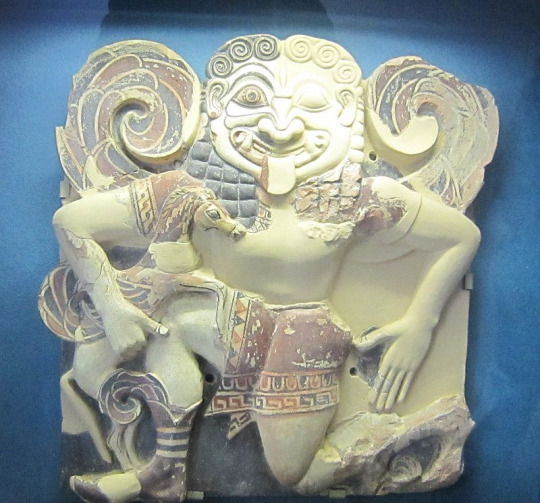

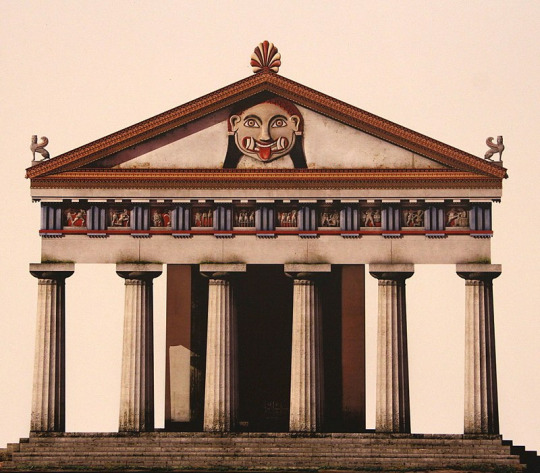
From the 5th century to the 2nd century BCE: A slow evolution as Medusa goes from a full-on monster to a human turned into a monster. As a result the two depictions of the grotesque and beautiful gorgoneion coexist.
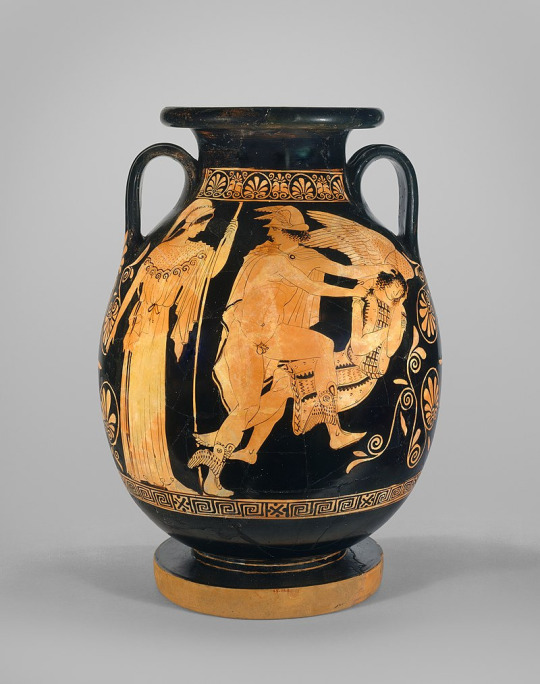


Post 2nd century BCE: Medusa is now a human with snake hair, and just that


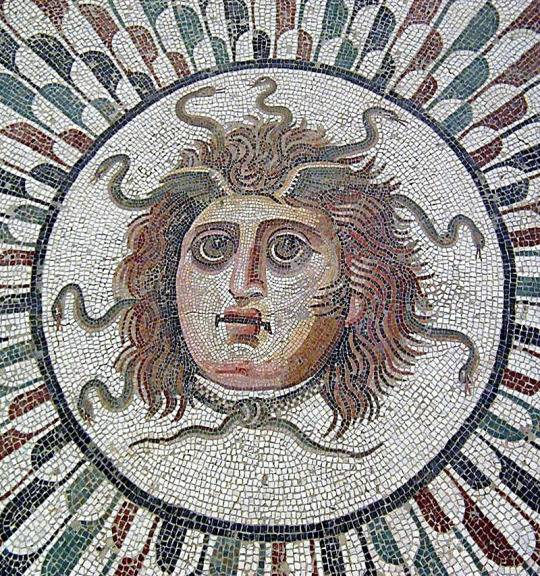
#greek mythology#medusa#gorgon#athena#gorgons#poseidon#neptune#minerva#ovid#rape in mythology#greek monsters#roman mythology
4K notes
·
View notes
Text
"Researchers found microplastics in soil deposits more than seven meters (23 feet) underground, which were deposited in the first or second century CE and excavated in the 1980s, a team led by researchers from the University of York in the United Kingdom said in a statement published Friday.
In total, the study identified 16 different microplastic polymer types in contemporary and archived soil samples, the statement adds.
[...]
“This feels like an important moment, confirming what we should have expected: that what were previously thought to be pristine archaeological deposits, ripe for investigation, are in fact contaminated with plastics, and that this includes deposits sampled and stored in the late 1980s,” John Schofield, a professor and director of studies in the University of York’s Department of Archaeology, said in the statement."
[...]
“Our best-preserved remains—for example, the Viking finds at Coppergate (in the city of York)— were in a consistent anaerobic waterlogged environment for over 1000 years, which preserved organic materials incredibly well,” he said in the statement.
“The presence of microplastics can and will change the chemistry of the soil, potentially introducing elements which will cause the organic remains to decay. If that is the case, preserving archaeology in situ may no longer be appropriate.”
2K notes
·
View notes
Text
Yo Goyim! Looks like I'm going to need to give some of you a crash course on what antisemitic language looks like, because I've been seeing entirely too much of it from some of you here on Tumblr.
Now, I think it's time for a Jewish history lesson, because I've been seeing way too many Nazi-related conspiracy theories going around. If you hear contradictions to the basic information that I am about to share (i.e., if you hear someone saying that the Jewish people are "a race that originated in Europe"), it is likely that you are hearing a white supremacist, anti-Jewish conspiracy theory.
So, here's the basics of Jewish history. Jews are indigenous to the Levant have been there for thousands of years. The Levantine people that Jews descended from have been in that area of the Levant since the Bronze Age. Jews as a distinct people have been there since the Late Bronze Age. Before it was Palestine it was the Kingdom of Judah, then Judea, and then Judaea, and that is literally where we are from. The word Jew means "a person from the Kingdom of Judah." The Romans renamed the area Syria-Palaestina (which they borrowed from the Greek name Palestina) in the 2nd century CE after destroying the Second Temple in Jerusalem and leading another campaign to try to eradicate the Jewish people (guess what, we're still here, motherfuckers).
And even after the Romans tried to annihilate us, even after they scattered many of us into European diaspora, many Jews came back, again and again over the ages, and there have nearly always been Jewish communities in the region throughout history.
And if you come for me or try to dispute any of this history with white supremacist bullshit, I am a Jew who has studied way more Jewish history than you. And as politely as possible, you can take your white supremacist conspiracy theories and fuck off into the sun.
Okay, with all that out of the way, let's get into it!
Gloves are coming off, because this is just a sampling of the Nazi dogwhistles I've been seeing here on Tumblr about the Jewish civilians who were tortured, murdered, and worse:
- If you say shit like, "The Jews got what they deserved"...
GUESS WHAT? You're talking like a white supremacist, and you need to fucking check yourself.
- And if, on the other hand, you say shit like, "The reports were probably overblown. I think those were paid actors. I don't think those Jews were murdered. No Jewish children were killed. No Jewish bodies were desecrated" blahblahblah...
GUESS WHAT? You get to sit with the Nazis at their table for lunch.
- If you tell Jews "go back to Europe where you came from"...
GUESS WHAT? Not only are you telling the descendants of Jewish refugees to go back to the Spanish Inquisition, the Russian pogroms, and the Nazi gas chambers, as I explained in this post, but you are also repeating a white supremacist conspiracy theory about the origins of European Jews.
Jews are a Levantine people from the area of the Middle East currently called Israel (formerly called the Kingdom of Judah, and then Judea). While there was some emigration to Europe during the late Roman Republic and the early days of the Roman Empire, the first mass migration of Jews to Europe was a forced migration. Gentiles from the Roman Empire dragged us there as captives after 70 CE, the year Rome destroyed the Second Temple.
- And if you're telling yourself that there are "good Jews" and "bad Jews," and those Jewish civilians were "bad Jews," so they deserved to be tortured and killed...
GUESS WHAT? You're spouting white supremacist ideology.
Antisemitism takes a long time to deprogram.
A lot of gentiles grow up with anti-Jewish ideology that they have never questioned.
And a lot of Christians are kept ignorant about Jewish history because preachers and priests fear it would make Christians question the many inaccuracies in the Bible.
But the first step in noticing antisemitic beliefs is to notice when you start singling people out *because* they are Jewish.
And I have been seeing some of you gleefully celebrating the murder of Jewish civilians *because* they are Jewish.
And that is antisemitism.
That is one step closer to the next generation of Jews getting shoved into the gas chambers. And there are only 16 million of us left in the entire world. We're 0.2% of the world's population. And we cannot afford another Holocaust.
And if your response to me saying that is, "Well, those Jews deserve it."
Guess what. You are making it easier for Nazis and white supremacists to spread hatred and commit acts of violence against Jewish people. And you will have to live with that blood on your conscience.
So...
If you are a gentile, and you see other gentiles repeating these kinds of white supremacist dogwhistles about Jewish people, here's how you can help:
1. MOST IMPORTANTLY: Help them direct their focus away from attacking random Jewish people online and towards helping Palestinians.
Actions that people can take right now are contributing to verified charities and relief organizations that help the people of Gaza. Only donate to organizations that are verified by CharityNavigator.org and CharityWatch.org.
2. Call that shit out. Tell people that they're being antisemitic, and explain that Jew-hatred is dangerous to Jewish people. Antisemitism gets Jews attacked and it gets Jews killed. In the US, many synagogues require round the clock security to protect against white supremacists who want to murder Jews. In Pittsburgh, my old home town, a group of Nazis from north of the city planned the murder of Jewish congregants at Tree of Life Synagogue, and so far only one of them (the gunman) has been arrested and convicted of the murders. The others are still at large.
3. Explain to them that it is antisemitic to celebrate someone's death *because* they're Jewish. ALSO, it is antisemitic to blame a random Jewish person for the actions of ANY government, whether that be the Israeli Government or the US Government.
4. Explain to people that they're not going to solve this conflict by posting antisemitic statements and memes online. All they will do is alienate the Jewish people in their lives and make those Jews feel scared and unsafe. And they will contribute to this current wave of antisemitism.
Antisemitic hatred doesn't help Palestinians. All it does is put Jewish people around the world in danger.
#tl;dr if you celebrate the murder of jews *because* they are jews you are an antisemite - end of story#just fyi - i will be monitoring the comments so if anyone posts anything antisemitic i will delete your comment and block you#antisemitism tw#jumblr
4K notes
·
View notes
Note
hi! you're great I love your work! I've got a weirdly specific archery question and thought I'd send it to you in case you'd find it fun to have a crack at
say you're an expert archer originally from Vietnam sometime in the late bronze age. say you're a super duper expert archer because it turns out you're immortal, and so you do your archery across Eurasia through the first millennium BCE and the first millennium CE and into the age where gunpowder weapons are evolving into cannons. that's a long time to be alive and you do lots of hunting and fighting with all kinds of bows and shooting styles, especially war archery on horseback. then you're out of the picture for a while, let's say you're peacefully sleeping for a handful of centuries. (this is about Quynh from The Old Guard who alas was not peacefully sleeping)
all of a sudden you blink and you've gone from the era where firearms were just starting to develop and maybe with this new flintlock thing guns could eventually get good enough to rival a bow and arrows— bam, now you're in the 21st century. what kinds of modern archery tech would you be most excited to try out? what would you think of a compound bow? Olympic style archery? plastic fletching?? how about the modern reproductions of what are now considered historical bows and shooting styles? is there anything about 21st century archery that you'd want to rant about at length? other opinions about these newfangled takes on your trusty old bow and arrows you care to share?
This is a phenomenal question, and thank you for asking it! Here’s my 2 cents:
The thing about modern archery is that for the most part, modern bows are designed to make it easier to be accurate, to the stage that modern target accuracy is probably better than it’s ever been historically.
BUT, if we assume Quynh is capable of feats of archery that match the level of melee combat skill that e.g. Andy has, then she doesn’t NEED it to be easier to be accurate.
My guess is that someone like her would actually find most modern archery developments needlessly slow and awkward. Compound bows and Olympic recurves are NOT designed for instinctive, fast shooting, and would probably feel quite restrictive once she got over how easy they made accuracy.
BUT, I imagine she would be blown away by the range and arrow speed that modern bows can generate, and there are some recurves (and at least one compound bow), that have been designed to make use of the efficiency of modern materials and bow design, while still allowing traditional shooting styles, and those, THOSE are something an ancient immortal archer might fall in love with! (FWIW, my own go-to is a horsebow made with carbon-fibre limbs and a modern limb profile, and for impact energy it can match some traditional bows with a draw weight that’s 50% greater. The Oneida eagle compound could trump that).
So yeah, it might take her a bit, but once she gets her hands on the right equipment, she’d be (even more) TERRIFYING!
1K notes
·
View notes
Text
I keep seeing a post going around saying that people should stop using the “colonized” names for cities in Israel/Palestine and should instead use the Arabic names.
I need you guys to be so for real right now, Hebrew is quite literally the indigenous language of the area. Like believe what you want about Israel, but Hebrew objectively and factually originated in that land. The earliest record of written Hebrew is the Khirbet Qeiyafa inscription, found near Beit Shemesh which dates back to the 11th-10th century BCE.
The first record of the name Jerusalem is in the Egyptian Execration Texts which date back to the 20th century BCE.
Arabic was introduced to the land in the 7th century CE. The first recorded use of “Al-Quds” was in the 9th century CE.
I could do this for every single ancient city in the land. Bethlehem, Hebron, Jericho, Jaffa, Beer Sheva, Acre, and Ashkelon all existed prior to the Arab conquests in the 7th century CE and the introduction of Arabic to the land.
The fact that we use the Hebrew names of these cities isn’t some conspiracy to make them sound “more Jewish”, the modern Hebrew names are direct descendants of the ancient Canaanite words for these places. Hebrew is the only surviving Canaanite language.
Believe what you want about Israel, but claiming that the Hebrew names for these cities are “colonial” names is a disgusting erasure of Jewish history in the land.
#israel#jews#jewish#hebrew#arabic#israel palestine conflict#palestine#I have a feeling I’m gonna get hate for this but honestly I had to say something#y’all are willingly spreading pan-Arabist propaganda
1K notes
·
View notes
Text
In addition to my Monkey Man post from earlier, the always kind & sweet Aparna Verma (author of The Phoenix King, check it out) asked that I do a thread on Hijras, & more of the history around them, South Asia, mythology (because that's my thing), & the positive inclusion of them in Monkey Man which I brought up in my gushing review.

Hijra: They are the transgender, eunuch, or intersex people in India who are officially recognized as the third sex throughout most countries in the Indian subcontinent. The trans community and history in India goes back a long way as being documented and officially recognized - far back as 12th century under the Delhi Sultanate in government records, and further back in our stories in Hinduism. The word itself is a Hindi word that's been roughly translated into English as "eunuch" commonly but it's not exactly accurate.
Hijras have been considered the third sex back in our ancient stories, and by 2014 got official recognition to identify as the third gender (neither male or female) legally. Pakistan, Nepal, Bangladesh, and India have accepted: eunuch, trans, intersex people & granted them the proper identification options on passports and other government official documents.
But let's get into some of the history surrounding the Hijra community (which for the longest time has been nomadic, and a part of India's long, rich, and sometimes, sadly, troubled history of nomadic tribes/people who have suffered a lot over the ages. Hijras and intersex people are mentioned as far back as in the Kama Sutra, as well as in the early writings of Manu Smriti in the 1st century CE (Common Era), specifically said that a third sex can exist if possessing equal male and female seed.
This concept of balancing male/female energies, seed, and halves is seen in two places in South Asian mythos/culture and connected to the Hijra history.

First, we have Aravan/Iravan (romanized) - who is also the patron deity of the transgender community. He is most commonly seen as a minor/village deity and is depicted in the Indian epic Mahabharata. Aravan is portrayed as having a heroic in the story and his self-sacrifice to the goddess Kali earns him a boon.

He requests to be married before his death. But because he is doomed to die so shortly after marriage, no one wants to marry him.
No one except Krishna, who adopts his female form Mohini (one of the legendary temptresses in mythology I've written about before) and marries him. It is through this union of male, and male presenting as female in the female form of Mohini that the seed of the Hijras is said to begun, and why the transgender community often worships Aravan and, another name for the community is Aravani - of/from Aravan.
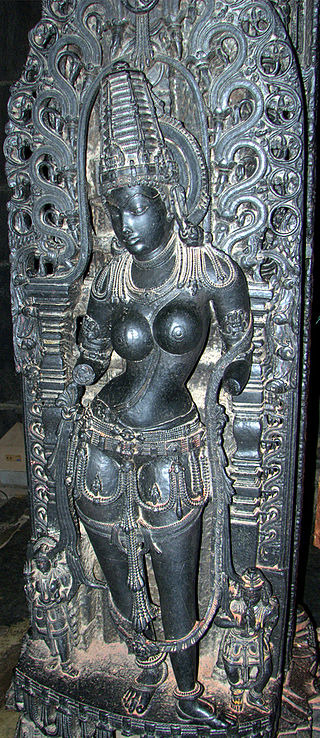
But that's not the only place where a gender non conforming divine representation can be seen. Ardhanarishvara is the half female form of lord Shiva, the destroyer god.
Shiva combines with his consort Parvarti and creates a form that represents the balancing/union between male/female energies and physically as a perfectly split down the middle half-male half-female being. This duality in nature has long been part of South Asian culture, spiritual and philosophical beliefs, and it must be noted the sexuality/gender has often been displayed as fluid in South Asian epics and the stories. It's nothing new.

Many celestial or cosmic level beings have expressed this, and defied modern western limiting beliefs on the ideas of these themes/possibilities/forms of existence.
Ardhanarishvara signifies "totality that lies beyond duality", "bi-unity of male and female in God" and "the bisexuality and therefore the non-duality" of the Supreme Being.
Back to the Hijra community.
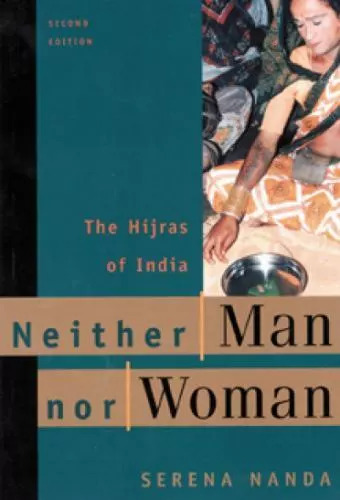
They have a complex and long history. Throughout time, and as commented on in the movie, Monkey Man, the Hijra community has faced ostracization, but also been incorporated into mainstream society there. During the time of the Dehli Sultanate and then later the Mughal Empire, Hijras actually served in the military and as military commanders in some records, they were also servants for wealthy households, manual laborers, political guardians, and it was seen as wise to put women under the protection of Hijras -- they often specifically served as the bodyguards and overseers of harems. A princess might be appointed a Hijra warrior to guard her.

But by the time of British colonialism, anti-Hijra laws began to come in place folded into laws against the many nomadic tribes of India (also shown in part in Monkey Man with Kid (portrayed by Dev Patel) and his family, who are possibly
one of those nomadic tribes that participated in early theater - sadly by caste often treated horribly and relegated to only the performing arts to make money (this is a guess based on the village play they were performing as no other details were given about his family).
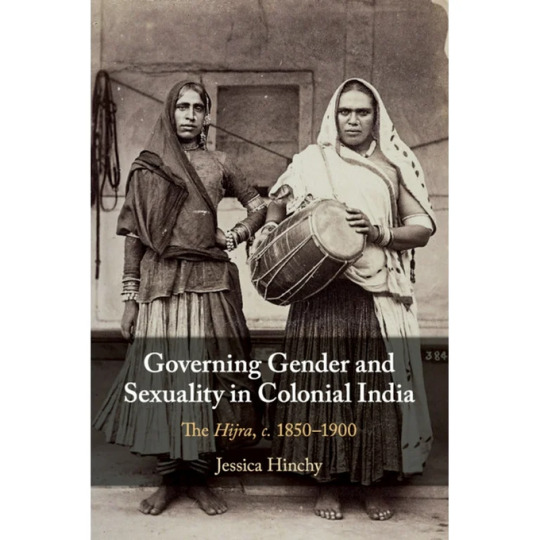
Hijras were criminalized in 1861 by the Indian Penal Code enforced by the British and were labeled specifically as "The Hijra Problem" -- leading to an anti-Hijra campaign across the subcontinent with following laws being enacted: punishing the practices of the Hijra community, and outlawing castration (something many Hijra did to themselves). Though, it should be noted many of the laws were rarely enforced by local Indian officials/officers. But, the British made a point to further the laws against them by later adding the Criminal Tribes Act in 1871, which targeted the Hijra community along with the other nomadic Indian tribes - it subjected them to registration, tracking/monitoring, stripping them of children, and their ability to sequester themselves in their nomadic lifestyle away from the British Colonial Rule.
Today, things have changed and Hijras are being seen once again in a more positive light (though not always and this is something Monkey Man balances by what's happened to the community in a few scenes, and the heroic return/scene with Dev and his warriors). All-hijra communities exist and sort of mirror the western concept of "found families" where they are safe haven/welcoming place trans folks and those identifying as intersex.
These communities also have their own secret language known as Hijra Farsi, which is loosely based on Hindi, but consists of a unique vocabulary of at least 1,000 words.
As noted above, in 2014, the trans community received more legal rights.
Specifically: In April 2014, Justice K. S. Radhakrishnan declared transgender to be the third gender in Indian law in National Legal Services Authority v. Union of India.
Hijras, Eunuchs, apart from binary gender, be treated as "third gender" for the purpose of safeguarding their rights under Part III of our Constitution and the laws made by the Parliament and the State Legislature. Transgender persons' right to decide their self-identified gender is also upheld and the Centre and State Governments are directed to grant legal recognition of their gender identity such as male, female or as third gender.
I've included some screenshots of (some, not all, and certainly not the only/definitive reads) books people can check out about SOME of the history. Not all again. This goes back ages and even our celestial beings/creatures have/do display gender non conforming ways.
There are also films that touch on Hijra history and life. But in regards to Monkey Man, which is what started this thread particularly and being asked to comment - it is a film that positively portrayed India's third sex and normalized it in its depiction. Kid the protagonist encounters a found family of Hijras at one point in the story (no spoilers for plot) and his interactions/acceptance, living with them is just normal. There's no explaining, justifying, anything to/for the audience. It simply is. And, it's a beautiful arc of the story of Kid finding himself in their care/company.
#hijra#trans representation#monkey man#dev patel#transgender#trans rights#trans rights are human rights#third sex#indian history#indian culture#colonialism#imperialism#south Asian mythos#South Asian myths#Aravan#Iravan#Mahabharata#hindu mythology#hindu gods#kali goddess#krishna#hindu mythology art#Ardhanarishvara#Shiva#Parvarti#sexuality#gender fluid#fluid sexuality#trans community#transgender rights
614 notes
·
View notes
Text

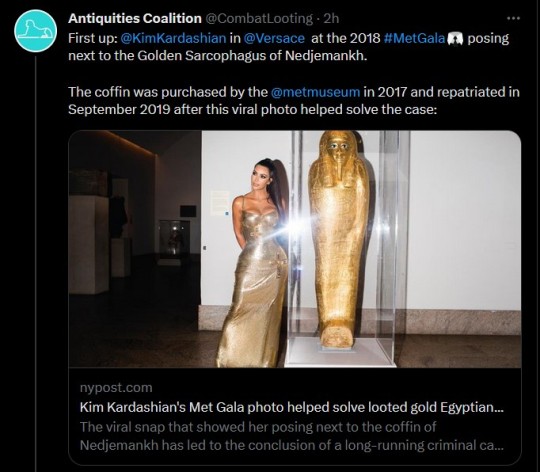
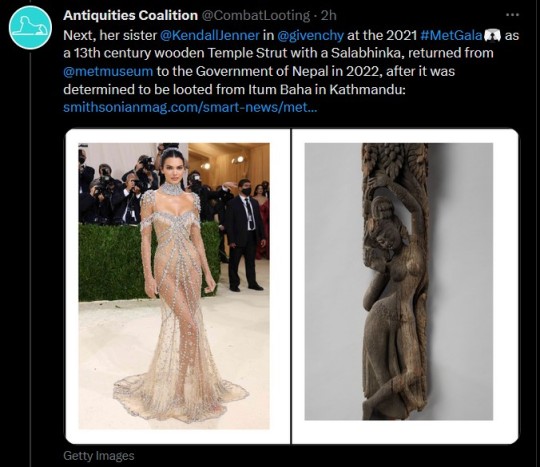
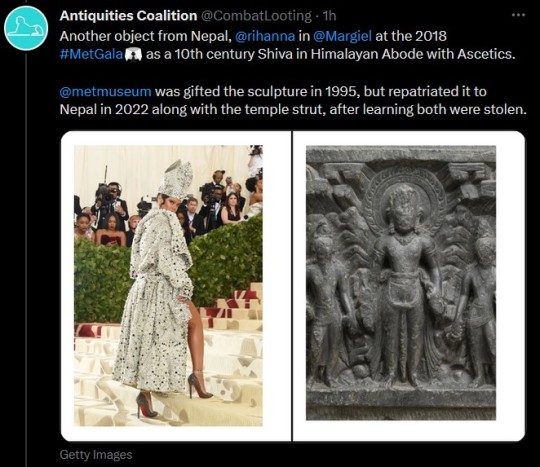

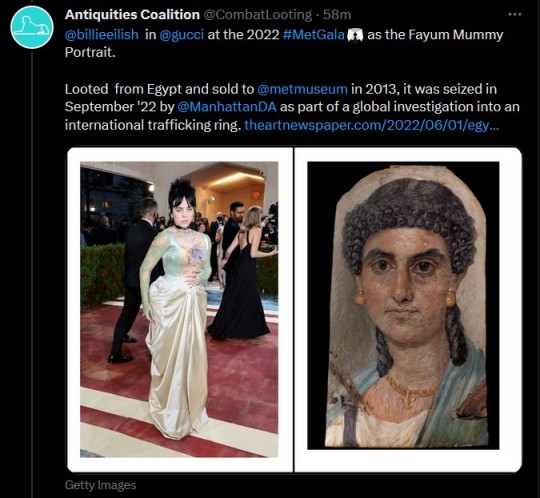
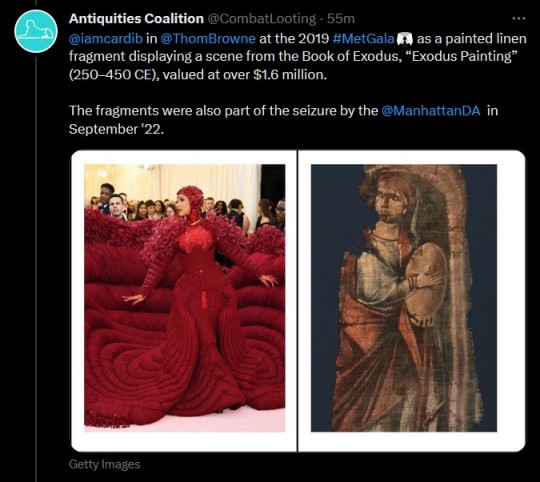
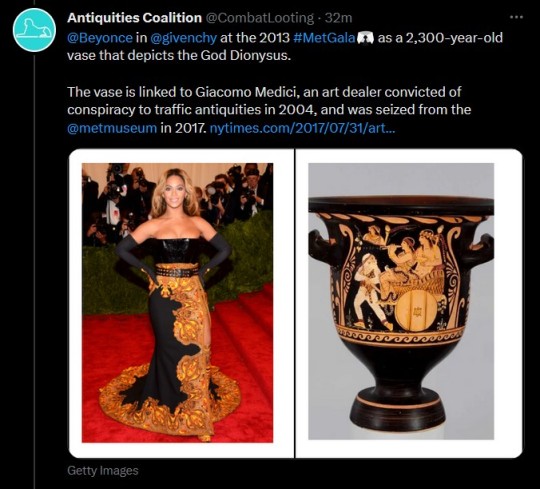
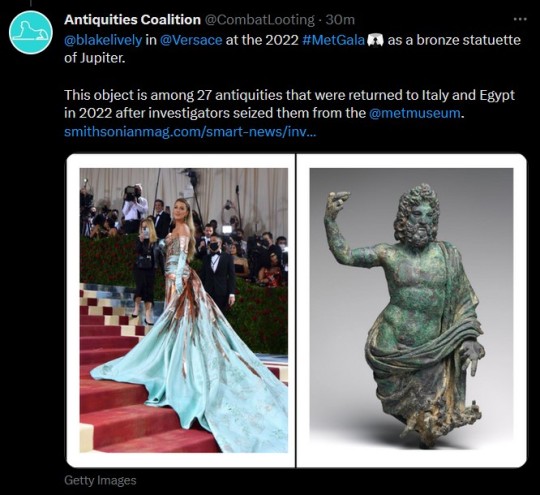
Looks vs. Loot at the Metropolitan Museum of Art by The Antiquities Coalition (@/CombatLooting) on Twitter
Transcription below the cut
1: The #MetGala may be "fashion's biggest night," but tonight's event hides some dark truths at @/metmuseum...including a long history of looted antiquities. To spotlight some of the contested objects from the Met's collection, we are featuring #MetGala vs. Loot [THREAD]
2. First up: @/KimKardashian in @/Versace at the 2018 #MetGala posing next to the Golden Sarcophagus of Nedjemankh. The coffin was purchased by @/metmuseum in 2017 and repatriated in 2019 after this viral photo helped solve the case. (link)
3. Next, her sister @/KendallJenner in @/givenchy at the 2021 #MetGala as the 13th century wooden Temple Strut with Salabhinka, returned from @/metmuseum to the Government of Nepal in 2022, after it was determined to be looked from Itum Baha in Kathmandu. (link)
4. Another object from Nepal, @/rihanna in @/Margiel at the 2018 #MetGala as a 10th century Shiva in Himalayan Adobe with Ascetics. @/metmuseum was gifted the sculpture in 1995, but repatriated it to Nepal in 2022 along with the temple strut, after learning both were stolen.
5. Dakota Johnson in @/gucci at the 2022 #MetGala as a terracotta kylix (c. 470 bCE). This piece, valued at $1.5 million, was seized from the @/metmuseum in July 2022 after being linked to Italian antiquities trafficker Gianfranco Becchina. (link)
6. @/billieeilish in @/gucci at the 2022 #MetGala as the Fayum Mummy Portrait. Looted from Egypt and sold to @/metmuseum in 2013, it was seized in September '22 by @/ManhattanDA as part of a global investigation into an international trafficking ring. (link)
7. @/iamcardib in @/ThomeBrowne at the 2019 #MetGala as a painted linen fragment displaying a scene from the Book of Exodus, 'Exodus Painting" (250-450 CE), valued at over $1.6 million. The fragments were also part of the seizure by the @/ManhattanDA in September '22.
8. @/Beyonce in @/givenchy at the 2013 #MetGala as a 2,300-year-old vase that depicts the god Dionysus. The vase is linked to Giacomo Medici, an art dealer convicted of conspiracy to traffic antiquities in 2004, and was seized from the @/metmuseum in 2017. (link)
9. @/blakelively in @/Versace at the 2022 #MetGala as a bronze statuette of Jupiter. This object is among 27 antiquities that were returned to Italy and Egypt in 2022 after investigators seized them from the @/metmuseum. (link)
5K notes
·
View notes
Text

The 2nd century CE Roman Barbegal watermill complex, a unique cluster of 16 waterwheels in southern France, was the first known attempt in Europe to set up an industrial-scale complex of machines. The mills had an estimated production capacity of 25 tonnes of flour per day
Blog
3K notes
·
View notes
Text
🧭 8th House: Your Biggest Challenges in Astrology 🧭

[You can book a personal reading with me, kindly check the pinned post <3]
Masterlist: All my astrology posts at one place

8th House in Astrology rules over everything that is the considered to be the challenging parts of life. It has positive connotations in a way that through these challenges we find our brightest light. The lessons in the 8th house present themselves through our connections with other people, whether its physically, mentally, emotionally or even spiritually. Because through our connection with others we learn about life. 8th house is also connected with debts, other people's resources, being involved in drama, but that's a topic for a different day. Let's see how you can use your 8th house to navigate your challenging lessons, so that the outcome is positive and growth oriented.
See where the ruler of your 8th house falls:
Check 8th House Sign (ex. Libra) -> Sign's Planetary Ruler (ex, Libra is ruled by Venus) -> Which house the ruler falls into (ex, Venus in 4th House)
The signs and their rulers: Don't use Uranus, Neptune and Pluto as rulers of any signs. Firstly it lack proper credits, and second it's just not it (found after 1700s). We rather rely on the Traditional Astrology that has been around for millenias (since about 2nd Century CE). It just makes so much more sense (I'm going to make a long detailed post about this).
Aries, Scorpio: Mars
Taurus, Libra: Venus
Gemini, Virgo: Mercury
Cancer: Moon
Leo: Sun
Sagittarius, Pisces: Jupiter
Capricorn, Aquarius: Saturn
If you have your ruler of the 8H in the 1H, all the lessons that you experience lead you back to yourself. It's an extremely self-development oriented aspect. Your challenges and lessons shape the way you view the world. So whenever such lessons strike, seek to understand how it alters the way you understand reality and life itself. These challenges are presented to you so that you can understand no one but yourself, better. You might have a bit of insecurities and self esteem issues, that result from challenging experiences. Seek to nurture yourself in whatever way you feel the most comfortable, and put your beliefs + values first and foremost.
If you have your ruler of the 8H in the 2H, you are here to practice healthy give and take. You experience people meddling in your business all the time. Perhaps you are always stuck with people using your for your resources or material possessions or simply taking more from you than they can ever return, vice versa. Your lesson is to prioritize yourself, but also not be greedy or manipulative with others. Try to not overly attach with material outcomes, and you shall see a much better flow of finances, resources, etc. Seek healthy ways of intermingling with others, of trading and making deals. Don't lessen your personal value for anyone.
If you have your ruler of the 8H in the 3H, your biggest lesson is to express your thoughts and ideas in a better way. If you have your Mercury here *as the ruler, then it means literally speech issues like stammering or even difficultly concentrating. If you have Moon here *as the ruler, then inability to express your emotions into words. Beware of gossip or spreading misinformation, and also consuming information that is unverified or unconfirmed, since you are much more prone to issues with miscommunication. Seek journaling or writing as it can help you regulate all those thoughts in a better way. And don't hold yourself back from speaking up.
If you have your ruler of the 8H in the 4H, you have this sense of privacy that you seek to protect at all costs. The issues you regularly struggle with have to do with being vulnerable and not being able to open up, or opening up too much with anyone. There could be issues with the home and family life, perhaps there are people constantly prying over your personal life or violating your boundaries, or some of your family members being a pain in the butt. There are many ways to tackle these issues, but the best one is too have proper and healthy boundaries, because you are not everyone else's business. Seek close and trusted people to confide in.
If you have your ruler of the 8H in 5H, you might struggle a lot with either being too serious or not being serious at all when it comes to life's pleasures and fun. Striking a balance is the key. People also take advantage of your light-hearted nature, therefore your must have healthy boundaries that allows you to protect your creative and happy space. People can meddle between your kids or your creative endeavors. Your biggest lessons come from you learning how to rely on your creative self expression. Do not be afraid to shine. Your light is very strong and you deserve to feel the best. Seek to explore cool forms of expression and prioritize your inner child.
If you have your ruler of the 8H in 6H, you are meant to prioritize your routines and learn how to be a more grounded/organized/productive person. The thing is you don't need to burn yourself out or push yourself to do tasks/things that simply aren't working out, just for the sake of it. Instead, set systems that actually suit you. Do not make grand resolutions that you actually cannot put to ground. You have a bit of challenge with the material realm, either being too obsessed with perfection or being super disorganized. Some can even have a bit of health issues. Seek balance and create a healthy lifestyle that you actually enjoy living with. Build systems and not routines.
If you have the ruler of your 8H in 7H, most of your challenges and transformative situations in life has to do with others. These could be relationships, partnerships, friendships and family. Through people, you learn and grow. If you have your Venus in the 7H *as the ruler of 8H, you experience very life changing things in regards to romance and building connections with others. If you have Mercury in the 7H *as the ruler of the 8H, you experience difficultly expressing yourself with others. If you have Moon in the 7H *as the ruler of the 8H, you may have attachment issues. So seek healthy forms of communication, expression, etc. Try to learn the healthy patters of being in relationships and don't hold onto people that stall you from moving forward. Easier said than done, but even being aware of yourself helps a ton!
If you have the ruler of your 8H in 8H, you might go through a lot of shitty situations, but you are tough af. This is actually a pretty good aspect because your challenges don't leak to other areas of your life. The only area it affects, ie, the 8H, is about getting involved in other people's lives deeply, psychology and the occult. So you may resort to things like shadow work, alternative healing, etc, to help you transmute all this shadow into light. With this aspect you need to make sure that you don't make 'healing' your entire identity or make your pain your identity, especially if you have a major planetary ruler such as Sun or Moon. You are here to learn about the deeper parts of life, and that is not always dark and shadowy. Sometimes the lessons you learn from other people can be your most motivating teachers in life. So, take it easy. It happens for you, not to you.
If you have the ruler of your 8H in the 9H, you are here to literally find the light at the end of the tunnel. If the 8H is about the shadow, 9H is about the light. Your lessons give you a really big opportunity to go towards the brighter side of things. And at the same time these lessons are very much ingrained with becoming more open minded with life, being interested in learning about life on a higher level such as philosophy or self development. On the other hand, these challenges can also be related with foreign travel, other cultures, higher education, global media platforms, philosophy, etc, so make sure you tackle these accordingly. You struggle more with letting go and getting "lucky" in life because you tend to get comfortable in the uncomfortable side of life. Seek to expand beyond your challenges, and resolve painful situations by connecting with your spiritual/religious side.
If you have the ruler of your 8H in the 10H, you biggest challenges steams from your career and public reputation. You tend to be a bit more secretive about your life when out in public, or simply view others as prying on your private life. People might become manipulative with you when it comes to your career and you might be prone to people spreading batshit about you all the time. There are a lot of ways these events can be tackled, but one of the advice is to not let others know information about your work or achievements unless they are someone you trust A LOT. People can use you to gain some type of fame or take credit for things they didn't even do. You publicly go through tough things, whether that 'public' is just relatives or a few friends/acquaintances. People always get to know about your challenges and lessons for some reason. So, be careful of how much you let random people know.
If you have the ruler of your 8H in the 11H, you experience a bit of similar situation as the ones who has their ruler in the 10H, but the difference is, people use your issues to propel themselves forward in some way or the other. For the 10H persons, people only spread rumors about them and talk about their issues. But for you, people use it to their advantage. You might have a bit of challenge with making genuine connections with others, as in networking and socializing (not personal relationships). These people can use you to advance their career, use and exploit your ideas and work to give themselves a boost. And you might also struggle with creating long term plans and holding your visions. So the advice for the manipulative people part is that hold on until you actually know that someone is trustworthy. And even then, don't tell them everything about your plans and your dreams. 11H or not, some people are very quick to take advantage of our dreams.
If you have the ruler of your 8H in 12H, first of all I want to do is give you a big hug! *sending a virtual hug*. The reason I say this is because both these houses have a reputation for bringing a lot of intense and transformative situations in a person's life in a variety of ways, but not everyone is able to instantly identity these toxic patterns and help themselves get out of it. With this placement your biggest challenges have a deeply rooted karmic hint to them. And almost all the time, it requires for you to understand what that karma is and end that cycle so that you can grow. Based on the planetary ruler in the 12H your situation can be the most intense to least intense, but what is asks for you is to identity the subconscious/subliminal patterns that keep you stuck in life, and transmute them into healing. Take it easy, don't make 'healing' your entire identity. Focus on grounding and your well-being, first and foremost.
Thank you for reading! Stay tuned for more Astrology content 🏹✨️!
#astrology#8h placements#8th house#natal chart reading#astrology readings#astrology chart readings#natal chart#astrologer
1K notes
·
View notes
Note
Hey, would you be willing to elaborate on that "disappearance of the Anasazi is bs" thing? I've heard something like that before but don't know much about it and would be interested to learn more. Or just like point me to a paper or yt video or something if you don't want to explain right now? Thanks!
I’m traveling to an archaeology conference right now, so this sounds like a great way to spend my airport time! @aurpiment you were wondering too—
“Anasazi” is an archaeological name given to the ancestral Puebloan cultural group in the US Southwest. It’s a Diné (Navajo) term and Modern Pueblos don’t like it and find it othering, so current archaeological best practices is to call this cultural group Ancestral Puebloans. (This is politically complicated because the Diné and Apache nations and groups still prefer “Anasazi” because through cultural interaction, mixing, and migration they also have ancestry among those people and they object to their ancestry being linguistically excluded… demonyms! Politically fraught always!)
However. The difficulties of explaining how descendant communities want to call this group kind of immediately shows: there are descendant communities. The “Anasazi” are Ancestral Purbloans. They are the ancestors of the modern Pueblos.
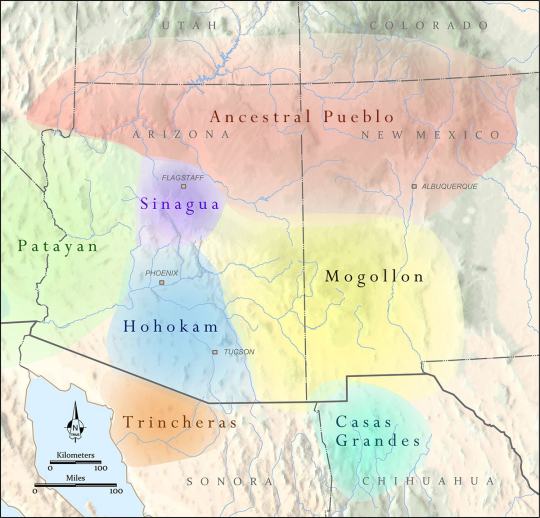
The Ancestral Puebloans as a distinct cultural group defined by similar material culture aspects arose 1200-500 BCE, depending on what you consider core cultural traits, and we generally stop talking about “Ancestral Puebloan” around 1450 CE. These were a group of people who lived in northern Arizona and New Mexico, and southern Colorado and Utah—the “Four Corners” region. There were of course different Ancestral Pueblo groups, political organizations, and cultures over the centuries—Chaco Canyon, Mesa Verde, Kayenta, Tusayan, Ancestral Hopi—but they generally share some traits like religious sodality worship in subterranean circular kivas, residence in square adobe roomblocks around central plazas, maize farming practices, and styles of coil-and-scrape constructed black-on-white and black-on-red pottery.
The most famous Ancestral Pueblo/“Anasazi” sites are the Cliff Palace and associated cliff dwellings of Mesa Verde in southwestern Colorado:

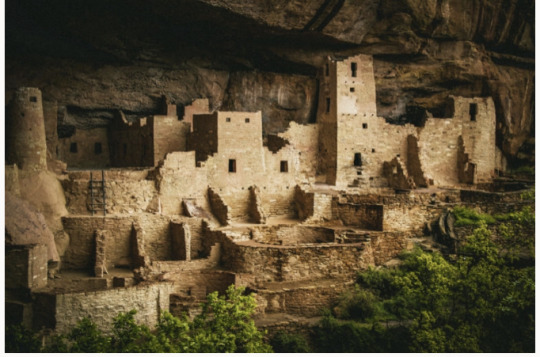
When Europeans/Euro-Americans first found these majestic places, people had not been living in them for centuries. It was a big mystery to them—where did the people who built these cliff cities go? SURELY they were too complex and dramatic to have been built by the Native people who currently lived along the Rio Grande and cited these places as the homes of their ancestors!
So. Like so much else in American history: this mystery is like, 75% racism.
But WHY did the people of Mesa Verde all suddenly leave en masse in the late 1200s, depopulating the whole Mesa Verde region and moving south? That was a mystery. But now—between tree-ring climatological studies, extensive archaeology in this region, and actually listening to Pueblo people’s historical narratives—a lot of it is pretty well-understood. Anything archaeological is inherently, somewhat mysterious, because we have to make our best interpretations of often-scant remaining data, but it’s not some Big Mystery. There was a drought, and people moved south to settle along rivers.
There’s more to it than that—the 21-year drought from 1275-1296 went on unusually long, but it also came at a time when the attempted re-establishment of Chaco cultural organization at the confusingly-and-also-racist-assuption-ly-named Aztec Ruin in northern New Mexico was on the decline anyway, and the political situation of Mesa Verde caused instability and conflict with the extra drought pressures, and archaeologists still strenuously debate whether Athabaskans (ancestors of the Navajo and Apache) moved into the Four Corners region in this time or later, and whether that caused any push-out pressures…
But when I tell people I study Southwest archaeology, I still often hear, “Oh, isn’t it still a big mystery, what happened to the Anasazi? Didn’t they disappear?”
And the answer is. They didn’t disappear. Their descendants simply now live at Hopi, Zuni, Taos, Picuris, Acoma, Cochiti, Isleta, Jemez, Laguna, Nambé, Ohkay Owingeh, Pojoaque, Sandia, San Felipe, Santa Clara, San Ildefonso, Tamaya/Santa Ana, Kewa/Santo Domingo, Tesuque, Zia, and Ysleta del Sur. And/or married into Navajo and Apache groups. The Anasazi/Ancestral Puebloans didn’t disappear any more than you can say the Ancient Romans disappeared because the Coliseum is a ruin that’s not used anymore. And honestly, for the majority of archaeological mysteries about “disappearance,” this is the answer—the socio-political organization changed to something less obvious in the archaeological record, but the people didn’t disappear, they’re still there.
444 notes
·
View notes
Photo

Kingdom of Abyssinia
The Kingdom of Abyssinia was founded in the 13th century CE and, transforming itself into the Ethiopian Empire via a series of military conquests, lasted until the 20th century CE. It was established by the kings of the Solomonid dynasty who, claiming descent from no less a figure than the Bible's King Solomon, would rule in an unbroken line throughout the state's long history. A Christian kingdom which spread the faith via military conquest and the establishment of churches and monasteries, its greatest threat came from the Muslim trading states of East Africa and southern Arabia and the migration of the Oromo people from the south. The combination of its rich Christian heritage, the cult of its emperors, and the geographical obstacles presented to invaders meant that the Ethiopian Empire would be one of only two African states never to be formally colonised by a European power.
Origins: Axum
The Ethiopian Highlands, with their reliable annual monsoon rainfall and fertile soil, had been successfully inhabited since the Stone Age. Agriculture and trade with Egypt, southern Arabia, and other African peoples ensured the rise of the powerful kingdom of Axum (also Aksum), which was founded in the 1st century CE. Flourishing from the 3rd to 6th century CE, and then surviving as a much smaller political entity into the 8th century CE, the Kingdom of Axum was the first sub-Saharan African state to officially adopt Christianity, c. 350 CE. Axum also created its own script, Ge'ez, which is still in use in Ethiopia today.
Across this Christian kingdom, churches were built, monasteries founded, and translations made of the Bible. The most important church was at Axum, the Church of Maryam Tsion, which, according to later Ethiopian medieval texts, housed the Ark of the Covenant. The Ark, meant to contain the original stone tablets of the Ten Commandments given by God to Moses, is supposed to be still there, but as nobody is ever allowed to see it, confirmation of its existence is difficult to achieve. The most important monastery in the Axum kingdom was at Debre Damo, founded by the 5th-century CE Byzantine ascetic Saint Aregawi, one of the celebrated Nine Saints who worked to spread Christianity in the region by establishing monasteries. The success of these endeavours meant that Christianity would continue to be practised in Ethiopia right into the 21st century CE.
The kingdom of Axum went into decline from the late 6th century CE, perhaps due to overuse of agricultural land, the incursion of western Bedja herders, and the increased competition for the Red Sea trade networks from Arab Muslims. The heartland of the Axum state shifted southwards while the city of Axum fared better than its namesake kingdom and has never lost its religious significance. In the 8th century CE, the Axumite port of Adulis was destroyed and the kingdom lost control of regional trade to the Muslims. It was the end of the state but not the culture.
Continue reading...
157 notes
·
View notes
Text
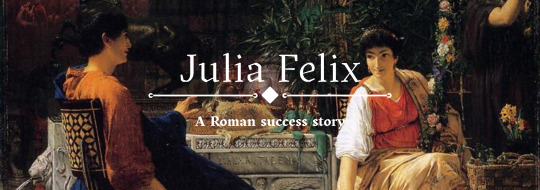
"Here’s what we know about Julia Felix: she lived in Pompeii from at least 62 CE. She was possibly illegitimate but was definitely not a member of the social and cultural elite. She worked for a living setting up and running a very interesting business and, by 79 CE, she had planned to shift her focus from managing a business to owning property. We know all these things because twentieth-century excavations at her business uncovered an advert, carved in stone and attached to the external wall of her huge building. It reads:
"To rent for the period of five years from the thirteenth day of next August to the thirteenth day of the sixth August, the Venus Bath fitted for the nogentium, shops with living quarters over the shops, apartments on the second floor located in the building of Julia Felix, daughter of Spurius. At the end of five years, the agreement is terminated."
This find illuminated the building it was attached to, bringing what otherwise looked like a very large anonymous domestic house into dazzling focus. With this description of the purpose of each room written by the owner herself, archaeologists and historians could see the site through a whole new lens and they realised that they had discovered a Roman entertainment space for the working middle classes. It is, so far, a completely unique find and it is magnificent. It offers us, as modern viewers, two amazing things: a little glimpse into the lives of the commercial classes of the Roman Empire who are so often completely and utterly invisible, and a brutal reminder that so much of what we ‘know’ about Roman women in the Roman world comes from rules concerning only the most elite.
We’ll do that second part first, because it’s the least fun. Roman written and legal sources are pretty universal in their agreement that although women could own property, they could not control it; they had no legal rights, could not make contracts and were to be treated as minors by the legal system for their entire lives. In order to buy or sell property women required a male guardian to oversee and sign off on any transactions. This is a basic truism of women in the Roman Empire, repeated ad nauseum by sources both ancient and modern including me, and it is undermined by Julia Felix’s rental notice.
The rental ad makes it pretty clear that Julia Felix is the owner-operator of a business complex including public baths, shops and apartments (there’s more too, as we’ll see), and she doesn’t seem to require anyone else to help her rent it out. She names her father – sort of; ‘Spurius’ might just mean that she is illegitimate – but this is effectively a surname, a personal identifier to differentiate her from other Julia Felixes in the area. It doesn’t mean her father was involved. Furthermore, the use of her father’s name as an identifier suggests that Julia didn’t have a husband and was either unmarried or widowed in 79 CE. The strong implication of her advert is that Julia Felix was an independent lady, a honey making money and a momma profiting dollars who could truthfully throw her hands up to Destiny’s Child.

We will never know if Julia escaped the flames and choking ash of 79 CE, fleeing as it swallowed her business and her home, but one discovery, made on 28 January 1952, suggests that she didn’t. The archaeologists, led by Amedeo Maiuri, uncovered on that day the skeleton of a woman who had fallen while running across the garden during the disaster. It’s clear this fallen woman was well off, because she was wearing a lot of gold jewellery. She carried four gold half-hoop earrings and wore four gold rings. Two of these rings were particularly expensive; both contained a red carnelian gem, one carved with a figure of Mercury, the other with an eagle. Around her neck she wore a necklace of gold filigree, dotted with ten pearls and hung with a green pendant. Someone stole both the necklace and earrings from the Pompeii Antiquarium in 1975 and no one, somehow, had ever bothered to photograph them so all we have are descriptions but the rings that survive are fine and expensive. The woman who wore them – was wearing them when she died – had real money to buy these objects and the woman who wore them did'nt leave Pompei in time.
Moreover, when she was found it was clear that at the moment of her death she was heading not towards the street or towards safety, but towards the shrine to Isis in the garden where all the most valuable possessions were kept. The valuable possessions that Julia Felix grafted for and maybe couldn’t bear to leave behind. There’s no way to tell whether this skeleton is Julia Felix, whether these bones once stood and looked at the plots of land Julia bought and made plans, or whether they belong to a looter or a chancer or someone just caught out. But it’s nice to pretend that Julia Felix, who shaped the city’s roads around her dream and offered respite and luxury to workers and made a tonne of money doing it, died and was buried with the place that still bears her name."
A Rome of One's Own: The Forgotten Women of the Roman Empire, Emma Southon
#julia felix#historyedit#history#women in history#ancient rome#pompei#businesswomen#italy#italian history#roman history#roman empire#1st century#historyblr#historical figures
201 notes
·
View notes